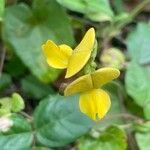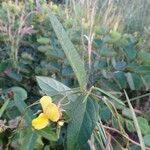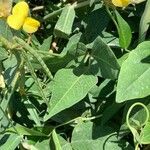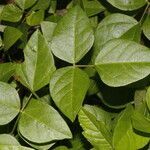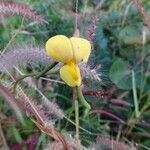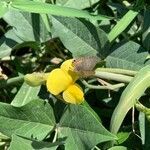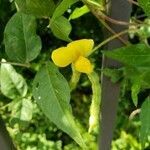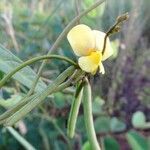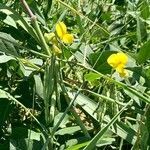Twining or trailing perennial herb 1.8-6 m long. Stem sparsely covered with appressed hairs to densely covered with spreading ferruginous hairs, glabrescent. Leaflets 3, 2.5-10 x 0.6-4.5 cm, ovate-lanceolate to lanceolate, more rarely linear-lanceolate, acute to obtuse and mucronate at the apex, rounded or cuneate to truncate at the base, sometimes slightly lobed or subhastate, sparsely pubescent to hairy on both surfaces; petiole 1.5-8.5 cm long; rhachis 0.5-1.8 cm long; stipules 2-5 x 1.5-2 mm, ovate to linear-lanceolate, bilobed at the base, multinerved. Peduncle 12-35 cm × 0.8-3 mm, glabrous; rhachis 1.5-5.5 cm long, 5-15-noded, internodes 1-8 mm long. Flower yellow, 12-20 x 14-22 mm; pedicel 3-7 mm long, expanding as the pod matures; bracteoles 1.5-4 x 1 mm, ovate-lanceolate to linear-lanceolate, 1-3-nerved. Calyx glabrescent to densely hairy; tube 2-4 mm long; lobes 1.5-4 mm long; the lower one almost twice as long as the others, the upper pair united into an acute, rounded and mucronate, or slightly bilobed lip. Standard with two centrally placed appendages; keel slightly twisted towards the right, with a short beak. Ovary 7-12-ovuled, rarely 13-14-ovuled (in Lake Tanganyika area). Pods 5.5-8 cm × 4-6.5 mm, linear, slightly compressed, curved, slightly constricted between the seeds, sparsely to densely covered with spreading ferruginous hairs, with a short curved beak. Seed 3.5-4.5 x 3-3.5 x 2-2.5 mm; hilum almost central, 1.5 mm long, oblong; rim aril not or scarcely developed.
Large scrambling and twining vine; stems tough, glabrous or hirsute, drying sulcate. Leaves pinnate trifoliolate; leaflets ovate, apically acute or obtuse, mu-cronate; basally obtuse, mostly 3-6 cm long, 1-3 cm wide, the costa and proximal portion of the 2 basal lateral veins prominent, other venation inconspicuous, glabrous or somewhat pilose, drying concolorous; petiolules 1-2 mm long, gla-brate; petioles slender, drying angled, glabrate, or somewhat pubescent above, shorter than the terminal leaflet; stipels ovate, ca. 1 mm long, glabrous, not striate. Inflorescences to 20 cm long, peduncle narrowing upwards, glabrate; bracteoles and bracts ovate, ca. 1 mm long, membranaceous and costate, ciliolate to erose; pedicels to 5 mm long, pubescent upwards, condensed at the apex of the peduncle. Flowers yellow; campanulate, the tube 3-6 mm long, glabrous, the teeth ciliate, shorter than the tube, the upper pair united, the others acuminate, the lowermost tooth narrow, slightly longer, glandular; standard 1.5 cm long, emarginate, the keel apically expanded and bent. Legume linear, 4-7 cm long, 5-8 mm wide, turgid, pubescent, maturing black; seeds ovoid, dark, 5-6 mm long, the hilum invaginated, white.
Trailing or twining herbs, 1.2-2.4 m. Stems with upper parts hairy or glabrescent. Stipules lanceolate, 3-4 × ca. 2 mm, 2-lobed at base; petiole 2-8 cm; leaflets ovate, ovate-elliptic, or ovate-lanceolate, rarely linear-lanceolate, 2.5-11 × 0.4-5 cm, sparsely pubescent on both surfaces or glabrous, base rounded or cuneate, margin entire, apex acute or acuminate. Racemes axillary; peduncles 5-40 cm; rachis 1.5-5 cm, 12-20-flowered; pedicels 4-9 mm, hirsute. Bracteoles ovate-lanceolate, 1.5-2 mm. Calyx pubescent or glabrescent; tube 3-4 mm; lobes deltoid, 2-4 mm, upper 2 wholly connate, apex acute or rarely 2-lobed. Standard yellow or greenish, sometimes tinged with red dorsally, oblate, 1.3-2.5 × 1.2-2.6 cm, glabrous, apex emarginate; wings obovate; keel shortly beaked. Legumes linear, 4-8 cm × 5-6.5 mm, pubescent, slightly constricted between seeds. Seeds dark brown or gray brown and with black spots, oblong or ovate-rhombic, 3-6 × 2-3.5 mm; hilum oblong.
Perennial climber, 0.3-1.5 m high/long; stems pubescent to glabrescent, hairs soft, silky. Leaflets narrowly to widely ovate, base cuneate, apex obtuse to emarginate. Stipules base cordate, apex acute. Inflorescences of elongated racemes, 3-15-flowered. Flowers yellow. Petals: standard oblate, emarginate. Style prolongation thick, obtuse, tongue-shaped. Flowering time July-Mar. Pod bunched at apex of peduncle, deflexed or spreading, partially compressed, slightly constricted between seeds, pubescent to glabrescent with long, appressed, soft hairs. Seeds 6-9.
A climbing herb. The stems are slender. They are tough and creeping. It keeps growing from year to year. They can be 6 m long. The leaves are alternate and have 3 leaflets. The leaflets are narrowly oval and 3-10 cm long by 1-5 cm wide. The flowers are yellow and like pea flowers. The fruit are long narrow pods. It is 6-8 cm long. They hang down. The seeds are dark red-brown or can be grey brown speckled with black. They are oblong.
Leaflets 3, 2.5–10 × 0.6–4.5 cm, ovate-lanceolate to lanceolate, more rarely linear-lanceolate, acute to obtuse and mucronate at the apex, rounded or cuneate to truncate at the base, sometimes slightly lobed or subhastate, sparsely pubescent to hairy on both surfaces; petiole 1.5–8.5 cm long; rhachis 0.5–1.8 cm long; stipules 2–5 × 1.5–2 mm, ovate to linear-lanceolate, bilobed at the base, multinerved.
Calyx glabrescent to densely hairy; tube 2–4 mm long; lobes 1.5–4 mm long; the lower one almost twice as long as the others, the upper pair united into an acute, rounded and mucronate, or slightly bilobed lip.
Pods 5.5–8 cm × 4–6.5 mm, linear, slightly compressed, curved, slightly constricted between the seeds, sparsely to densely covered with spreading ferruginous hairs, with a short curved beak.
Flower yellow, 12–20 × 14–22 mm; pedicel 3–7 mm long, expanding as the pod matures; bracteoles 1.5–4 × 1 mm, ovate-lanceolate to linear-lanceolate, 1–3-nerved.
Seed 3.5–4.5 × 3–3.5 × 2–2.5 mm; hilum almost central, 1.5 mm long, oblong; rim aril not or scarcely developed.
Stem sparsely covered with appressed hairs to densely covered with spreading ferruginous hairs, glabrescent.
Standard with two centrally placed appendages; keel slightly twisted towards the right, with a short beak.
Peduncle 12–35 cm × 0.8–3 mm, glabrous; rhachis 1.5–5.5 cm long, 5–15-noded, internodes 1–8 mm long.
Ovary 7–12-ovuled, rarely 13–14-ovuled (in Lake Tanganyika area).
Twining or trailing perennial herb 1.8–6 m long.
Yellow flowers
A twiner
